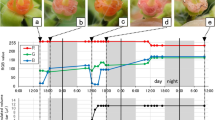Abstract
Flowers ofOxalis martiana open in the morning and close in the afternoon repeatedly for 3–5 days in May–July under natural conditions. Both in light and in darkness, the closed flowers opened in reponse to a rise in temperature (thermonasty), but not under the constant temperatures. Transfer from darkness to light along with temperature rise caused rapid flower opening, and at 20 C or higher temperatures, exposure to light caused flower opening even without changing temperature (photonasty). Therefore, the temperature of the night before opening is critical in determining whether the flower opening under natural conditions depends on thermonasty or photonasty. The opened flowers closed about 8–11 hr after the beginning of opening both under natural conditions and constant light-temperature conditions, which suggests that the time of flower closing is determined by endogenous factors. Length of the perianth increased greatly during opening and slightly during closing. Application of actionomycin D or cycloheximide inhibited both the flower opening and closing, probably by suppressing the perianth growth.
Similar content being viewed by others
Abbreviations
- Act D:
-
actinomycin D
- CH:
-
cycloheximide
References
Engelmann, W. 1960. Endogene Rhythmik und photoperiodische Blühinduktion beiKalanchoe. Planta55: 496–511.
Kaihara, S. andA. Takimoto. 1979. Environmental factors controlling the time of floweropening inPharbitis nil. Plant Cell Physiol.20: 1659–1666.
Karvé, A., W. Engelmann andG. Schoser. 1961. Initiation of rhythmical petal movements inKalanchoe blossfeldiana by transfer from continuous darkness to continuous light or vice versa. Planta56: 700–711.
Overland, L. 1960. Endogenous rhythm in opening and odor of flowers ofCestrum nocturnum. Amer. J. Bot.47: 378–382.
Takimoto, A. 1986. Oenothera.In A.H. Halevy, ed., Handbook of Flowering, vol. 5, pp. 231–236. CRC Press, Boca Raton.
Tanaka, O., Y. Tanaka andH. Wada. 1988. Photonastic and thermonastic opening of capitulum in dandelion,Taraxacum officinale andTaraxacum japonicum. Bot. Mag. Tokyo101: 103–110.
—H. Wada, T. Yokoyama andH. Murakami. 1987. Environmental factors controlling capitulum opening and closing of dandelion,Taraxacum albidum. Plant Cell Physiol.28: 727–730.
Wood, W.M.L. 1953. Thermonasty in tulip and crocus flowers. J. Exp. Bot.4: 65–77.
Zimmer, R. 1962. Phasenverschiebung und andere Störlichtwirkungen auf die endogen tagesperiodischen Blutenblattbewegungen vonKalanchoë blossfeldiana. Planta58: 283–300.
Author information
Authors and Affiliations
Rights and permissions
About this article
Cite this article
Tanaka, O., Murakami, H., Wada, H. et al. Flower opening and closing ofOxalis martiana . Bot Mag Tokyo 102, 245–253 (1989). https://doi.org/10.1007/BF02488567
Received:
Accepted:
Issue Date:
DOI: https://doi.org/10.1007/BF02488567




